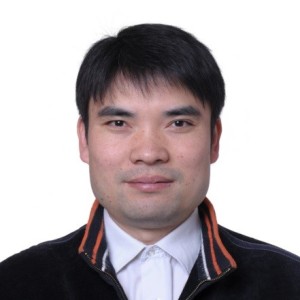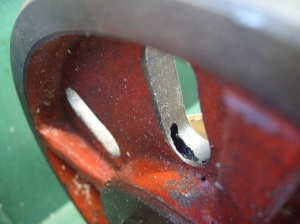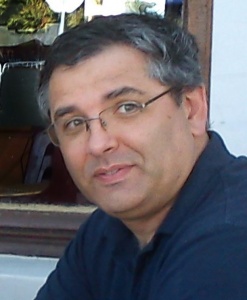One of Skoltech’s main goals is establishing strong and substantial cooperation relations with key industrial players. Airbus and Philips are most certainly such players, and a delegation from both companies visited Skoltech to establish working relationships and identify promising areas of cooperation. The delegation was led by Dr. Jean Boti, chief technical officer at Airbus group, who soon will takes over as Philips director of innovations and strategy. Читать далее
Сколтех — новый технологический университет, созданный в 2011 году в Москве командой российских и зарубежных профессоров с мировым именем. Здесь преподают действующие ученые, студентам дана свобода в выборе дисциплин, обучение включает работу над собственным исследовательским проектом, стажировку в индустрии, предпринимательскую подготовку и постоянное нахождение в международной среде.
Архив метки: materials
Double Skoltech Colloquium
We are pleased to invite you to a special edition of Skoltech Colloquium: double colloquium.
From a Simple Chemical Concept to Three-Dimensional Topological Materials: Principles and Applications
Guest speaker: Professor Xing-Qiu CHEN, Shenyang National Laboratory for Materials Science, Institute of Metal Research, Chinese Academy of Sciences
Xing-Qiu Chen received his Ph.D degree in Physical Chemistry from the University of Vienna in 2004. Afterwards, he took postdoctoral studies in the Vienna Center for Computational Materials Science (CMS) and at the Oak Ridge National Laboratory (ORNL) in the Materials Science and Technology Division. In 2010, he moved to Shenyang, starting his new position as a Research Staff Member funded by a CAS “Hundred Talent Project” at Institute of Metal Research. His main scientific interests are concerned with the computer modeling of materials properties and designs using quantum mechanical methodologies. To date, he has already published over 80 pre-review papers in scientific journals (including 1 Nature Chemistry, 1 Nature Communications, 7 Phys. Rev. Lett, 1 Advanced Materials). Among them, four have been selected in the ISI highly cited articles (top 1%). He has actively participated in international conferences and served scientific community. Currently, he still is the editorial board members of four journals Metals, Journal of Materials Science and Technology, Science China Materials and Scientific Reports.
and
The Formation Mechanism of Macro-Segregation in Solidifying Steels
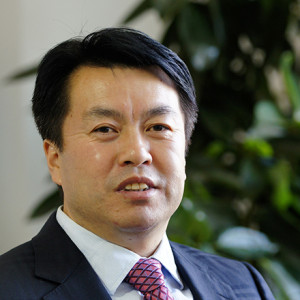 Guest speaker: Dianzhong LI (Professor, Ph.D), Head of the Materials Process Modeling Division, Shenyang National Laboratory for Materials Science, Institute of Metal Research, Chinese Academy of Sciences
Guest speaker: Dianzhong LI (Professor, Ph.D), Head of the Materials Process Modeling Division, Shenyang National Laboratory for Materials Science, Institute of Metal Research, Chinese Academy of Sciences
Professor Dianzhong Li the head of Materials Process Modelling Division of Shenyang National Laboratory for Materials Science (SYNL), Institute of Metal Research (IMR), Chinese Academy of Sciences (CAS). He joined CAS by the “Hundred Talented Program” in 1998. Now his research interests focus on the fabrication of the heavy castings and forgings and the high-quality special steels through controlling the macroscopic defects and microstructures, the modeling of the nucleation and growth of solidification structure and solid phase transformation in steels during deformation, the in-situ observation and modeling of liquid metal flow. He has been awarded as Second Prize for National Science and Technology Progress Awards (2012), Outstanding Science and Technology Achievement Prize of Chinese Academy of Sciences (2009) and Prize for Scientific and Technological Innovation by Ho Leung Ho Lee Foundation (2007). More than 100 scientific papers have been published on the peer-in-review journals such as Nature Communications, Acta Materialia. More than 40 invention patents and 2 softwares have been authorized by China.
We are looking forward to seeing you! In the meantime we invite you to check the schedule of the next colloquia.
For further information or questions, please e-mail Ekaterina Kuzmina at
Если у Вас возникли вопросы и/или Вы хотели бы зарегистрироваться на событие, пожалуйста, Лилии Абаимовой. Рабочий язык мероприятия – английский, вход свободный. Приходите, мы будем рады видеть Вас!
Seminar: Defects And Their Association: The “Hidden Factor” Behind The Material’s Properties
The need to comprehend and even embrace defects is not only a matter of life philosophy. It has many crucial implications. Dr. Artem Abakumov of the University of Antwerp , Belgium, discusses in his guest lecture “Defects and Their Association”, the “hidden factor” behind materials’ properties.
When: October 2, 2014; 13.30 – 15.00
Where: Beijing-1 Auditorium, China cluster; Skolkovo School of Management
SEMINAR ABSTRACT:
The macroscopic behavior of many materials largely depends on the nature and concentration of the defects, their mutual interaction and ordering patterns. Association of the defects can lead to complex microstructural states that are strikingly different from an averaged picture based on random distributions of defect species.
Often such short- or long-range ordered states are “hidden” because of high spatial inhomogeneity of the ordered states or intricate patterns of occupational and displacive incommensurate modulations. In this talk I will demonstrate that unexpected ordering patterns of defects can be uncovered in many well-characterized materials with a combination of advanced local and bulk structure characterization techniques and modern crystallographic approaches.
The pivotal role of intersite repulsion, local strain, lone electron pair effect and Jahn-Teller distortion in the collective behavior of the structural defects will be exemplified using the mixed ionic-electronic conductor Sr4Fe6O12 with the perovskite and rock-salt intergrowth structure, Pb-doped anion-deficient derivative of the multiferroic BiFeO3 perovskite and cation-ordered layered rock-salt type Na-ion battery material NaMnO2, with the emphasis on the link between the defect structure and the properties.
With these examples, I will also illustrate how powerful the modern transmission electron microscopy methods can be in gathering the structural and chemical information on the atomic scale.
SPEAKER INTRODUCTION:
Dr. Artem Abakumov
EMAT, University of Antwerp, Groenenborgerlaan 171, B-2020, Antwerp Belgium
Department of Chemistry, Moscow State University, 119991, Moscow, Russia
Dr. Artem Abakumov graduated from the Department of Chemistry at Moscow State University in 1993 and received his PhD in Chemistry from the same University in 1997. He spent about three years as a postdoctoral fellow and invited professor in the Electron Microscopy for Materials Research (EMAT) laboratory at University of Antwerp and joined EMAT as a research leader in 2008. His research is focused at understanding the crystal and defect structure of inorganic solids and linking this knowledge to designing new materials and getting deeper insight into their functional properties. His interests comprise inorganic solid state chemistry, complex transition metal oxides, aperiodic structures, conventional and multidimensional crystallography, structure analysis using a combination of transmission electron microscopy, synchrotron X-ray and neutron powder diffraction.
* The Skolkovo Institute of Science and Technology (Skoltech) is a private graduate research university in Skolkovo, Russia, a suburb of Moscow. Established in 2011 in collaboration with MIT, Skoltech educates global leaders in innovation, advances scientific knowledge, and fosters new technologies to address critical issues facing Russia and the world. Applying international research and educational models, the university integrates the best Russian scientific traditions with twenty-first century entrepreneurship and innovation.
Если у Вас возникли вопросы и/или Вы хотели бы зарегистрироваться на событие, пожалуйста, Лилии Абаимовой. Рабочий язык мероприятия – английский, вход свободный. Приходите, мы будем рады видеть Вас!
Seminar May 5: Cracking the Cracks in Crystalline Materials
They say that those ‘perfect’ diamonds are forever.
‘Flawless’ snowflakes are endlessly changing. And a pinch of table salt can turn your dreary sandwich into an ideal snack. But crystals are imperfect. Ask Dr. Alexander Shapeev from the UNiversity of Minnesota who devotes his research to computing minuscule faults in grand crystals.
Monday, May 5, 2014 13.30 – 15.00
Beijing-1 Auditorium, China cluster
Skolkovo School of Management
Title: «COMPUTATIONAL METHODS FOR CRYSTALLINE DEFECTS: CONSTRUCTION, ANALYSIS, AND BENCHMARKING»
SEMINAR ABSTRACT: Defects, defined as irregularities in the periodic arrangement of atoms, determine various important properties of crystalline materials. Such crucial features are plasticity or failure.
Computing defects such as dislocations or cracks is often challenging, because the spatial and temporal scales accessible for direct molecular simulations are limited. Dr. Shapeev’s talk will be devoted to efficient methods for computing crystalline defects. He will focus on atomistic-to-continuum (AtC) coupling, a popular approach utilizing atomistic resolution near the defect core while using the continuum model to resolve the elastic far-field.
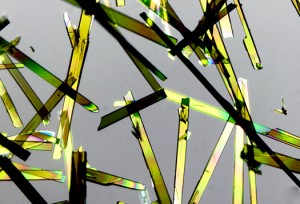
Nobody is perfect. Not even crystals
In his talk Dr. Alexander Shapeev will
- Give a brief introduction to crystalline defects and AtC coupling.
- Report one of the recent developments in construction of a consistent energy-based AtC coupling method.
- Present a mathematical theory of how to optimize and compare the performance of existing methods.
The first part of the talk will be devoted to his past research on computing static properties of defects, such as atomistic configuration or formation energy. In the second part, Alexander will speak about the present research and future plans on dynamics of defects and finite temperature.
SPEAKER INTRODUCTION:
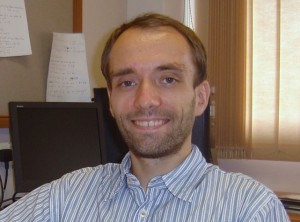
Dr. Alexander Shapeev
Alexander Shapeev is a postdoctoral associate in the Department of Mathematics in the University of Minnesota. He obtained his bachelor’s and master’s degree from the Novosibirsk State University and his PhD degree in mathematics from the National University of Singapore.
His research interests lie in applying computational mathematics to materials science and related fields. His current research is devoted to developing a mathematical theory and new computational methods for materials defects (such as dislocations or cracks). Alexander is an author of 11 peer-reviewed papers, one of which has been awarded the 2013 SIAM Outstanding Paper Prize.
* The Skolkovo Institute of Science and Technology (Skoltech) is a private graduate research university in Skolkovo, Russia, a suburb of Moscow. Established in 2011 in collaboration with MIT, Skoltech educates global leaders in innovation, advance scientific knowledge, and foster new technologies to address critical issues facing Russia and the world. Applying international research and educational models, the university integrates the best Russian scientific traditions with twenty-first century entrepreneurship and innovation.
Если у Вас возникли вопросы и/или Вы хотели бы зарегистрироваться на событие, пожалуйста, Лилии Абаимовой. Рабочий язык мероприятия – английский, вход свободный. Приходите, мы будем рады видеть Вас!

